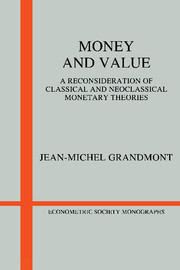3 - Classical stationary states with money and credit
Published online by Cambridge University Press: 05 January 2013
Summary
The aim of this chapter is to study the existence and the properties of steady states in the credit money economy that was analyzed in the preceding chapter, when population is stationary. Such steady states are defined as sequences of short-run equilibria (in the sense of the previous chapter), where the nominal interest rate, the relative prices of goods, and the rate of inflation - and more generally all “real” equilibrium magnitudes - are constant over time. Moreover, traders are assumed to forecast future prices and interest rates correctly at every moment. Although we have shown that the existence of a short-run equilibrium was doubtful in economies of this type, steady states are of independent interest because they may obtain as long-run equilibria of other dynamic (e.g., disequilibrium) processes.
It will be established that quantity theory and the classical dichotomy are valid propositions when applied to steady states. Real magnitudes (the relative prices of goods, the real rate of interest, the traders' consumptions) are determined by the equilibrium conditions of the goods markets. Nominal values (the money prices of goods, the rate of inflation, the nominal interest rate) are determined in turn by looking at the money sector, including the Bank's monetary policy. In particular, when population is stationary, the money prices of goods are proportional at any time to the level of monetary aggregates such as outside money or the Bank's money supply. In other words, prices and monetary aggregates grow at the same rate.
- Type
- Chapter
- Information
- Money and ValueA Reconsideration of Classical and Neoclassical Monetary Economics, pp. 96 - 121Publisher: Cambridge University PressPrint publication year: 1983



